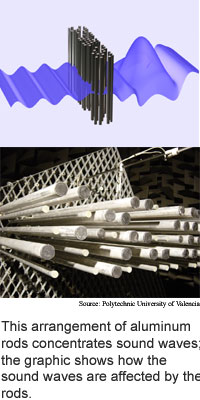
Rod arrays focus sound
Researchers from the Polytechnic University
of Valencia in Spain have produced a pair of flat lenses that control
soundwaves.
The lenses could eventually be used in acoustic microscopes that
use sound waves to examine the internal composition of objects and materials.
They could also be used in non-invasive surgical tools like lithotripsy
apparatus, according to the researchers. Lithotripsy is a medical procedure
that uses ultrasound to pulverize kidney stones.
The flat acoustic lenses are made of irregularly spaced arrays
of aluminum cylinders. The design was produced by a tool that combines
multiple scattering theory and a genetic algorithm, and is optimized to
concentrate sound waves at a focal point.
Multiple scattering theory is the mathematical framework for modeling
the way waves moved through inhomogenous substances. Genetic algorithms
take a design through many random iterations by randomly combining the
best designs of a set to produce a new design.
The researchers have a pair of prototype lens designs. Both use
aluminum cylinders that are one, two and three centimeters in diameter
and two meters long. One design has five layers and the other nine layers.
The cylinders occupy some of the points in a hexagonal lattice, creating
a pattern determined by the genetic algorithm. The lenses are considered
flat because the cylinders are confined to a rectangular area. Both amplify
sound up to 6.4 decibels at a focal point.
The researchers are also working on an electromagnetic counterpart
to the acoustic lens, dubbed Scattering Optical Elements.
The acoustic method could find practical application in two to
five years, according to the researchers. The work appeared in the January
1, 2005 issue of Applied Physics Letters.
Humanoid robots walk naturally
Software gives descriptive directions
Springs simplify micromirror arrays
Impact Assessment:
Roadside Eye Catchers
Briefs:
Process yields semiconductor foam
Rod arrays focus sound
Metal atoms make silicon magnetic
Speech software makes concept maps
Tiny transistors sniff chemicals
Plastic changes color in heat
Light writes data in electrons

Research Watch blog
View from the High Ground Q&A
How It Works
RSS Feeds:
News
Ad links:
Buy an ad link
Ad links: Clear History
Buy an ad link
|
TRN
Newswire and Headline Feeds for Web sites
|
© Copyright Technology Research News, LLC 2000-2010. All rights reserved.